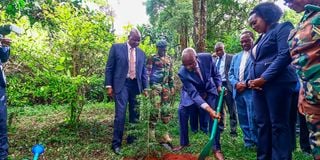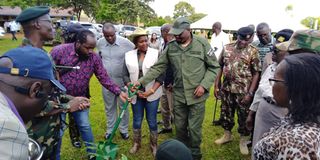Premium
Numbers don't lie: Why Ruto's plan to plant 15bn trees by 2032 is a tall order

Education CS Ezekiel Machogu plants a tree seedling with Environment CS Soipan Tuya (right) and other stakeholders at the Nairobi Arboretum grounds on April 2, 2024.
Kenya's plan to plant 15 billion trees in 10 years —1.5 billion a year, 125 million a month and four million a day — seems like a tall order. The country has only managed to plant 750 million tree seedlings since September 2022, well short of the three billion mark.
President William Ruto’s government had announced a goal to increase the country’s tree cover in the country to 30 per cent by planting 15.9 billion trees (10.6 million hectares) in 10 years for climate change resilience, mitigation and improved livelihoods.
The government announced today May 10 as a public holiday for Kenyans to plant trees. It is targeting to plant at least 200 million seedlings today.
“On this day, we call upon all Kenyans to turn out in large numbers to grow trees and participate in ecosystem restoration activities within their neighbourhoods and designated sites across the country. Our ambition for this day is for every Kenyan adult to grow a minimum of 50 seedlings and every Kenyan child 10 seedlings, to contribute to our national target of planting a record 1 billion seedlings in one day,” Ms Soipan Tuya, the Environment, Climate Change and Forestry Cabinet Secretary said in a statement.
Ms Tuya asked Kenyans to take photos of them planting the trees and send them to the ‘Jaza Miti’ (Fill the trees) platform.
But besides the number problem, Kenya is facing yet another set of problems: Failure to roll out the strategy, some understaffing and failure to fill key positions, and the idea that the process depends on Kenyans’ goodwill, with no access to free seedlings.
30 per cent tree cover
The national strategy for achieving and maintaining over 30 per cent tree cover by 2032 is yet to be implemented through the Special Presidential Forestry and Rangeland Restoration Program popularly referred to as ‘Jaza Miti’.

CS Moses Kuria leads tree planting at Mulaha Primary School in Siaya Town on May 10, 2023.
This is despite the strategy being adopted and approved by Cabinet in December 2022 with the Treasury releasing money to implement it.
The project also faces a setback over the failure to recruit a substantive senior staff in the state department to spearhead the strategy, also known as Forest Conservation Secretary (FCS), a position unfilled for almost a decade.
“The FCS is directly answerable to the Principal Secretary (PS) and coordinates all the agencies under the Ministry on behalf of the PS. He also liaises with other ministries, departments and agencies (MDAs) on matters forestry countrywide,” a high-ranking official disclosed.
The strategy, the source says, has never undergone public participation for the public to understand and own it.
To effectively coordinate the implementation, monitoring and reporting, several governance structures were to be established. This includes a national coordination committee, a multi-institutional technical committee, a county implantation coordinating committee and a sub-county level coordination committee.
This is yet to happen and means that the strategy lacks the governors’ structures which on conception were designed to drive its implementation from the national to the grassroots, sub-county level – “Whole-government Whole-society approach”.
Secondly, in the strategy document adopted and approved by the Cabinet, it was stipulated that there shall be a secretariat domiciled at the Environment Ministry.
As per the approved strategy, the secretariat was to constitute a multi-institutional team with representatives from relevant government agencies, the Council of Governors, NGOs, the private sector and development partners’ representatives.
These were to be put in place instead of an amorphous secretariat (comprising of ‘non-foresters’ such as human resource personnel, agriculturist economists, politicians, and administrators) that was created to run the show without the professional input of the technical officers in the state department of Forestry, the senior official noted.
“The National Tree Planting Committee has never met to deliberate on the national tree planting programme,” the official said.
But Charity Munyasia, the senior deputy chief conservator of forests at Kenya Forest Service (KFS), said that she is convinced that Kenya is going to plant 15 billion trees even before ten years elapse as long as resources are made available.
Budgetary allocations
On budgetary allocations, she said: “Before this government showed up, we were getting zero budget for five years but last year, we received Sh20 million for plantation development.”
She also refuted claims that there was a go-slow at KFS and that the staff is demoralised over promotions.
“1300, officers were promoted at KFS this year, any promotion or employment requires resources. Thanks to President William Ruto and CS Soipan Tuya, the government has employed 2,664 rangers and 300 forest officers,” she said, adding that KFS is currently waiting for the next batch of 300 officers.
“The last time the government employed forest rangers was in 1996, this shows you how the government is committed to planting 15 billion trees by 2032.”
“There is no quick fix. I can assure you that having worked in the forestry sector for 34 years, I am confident that with resources to establish nurseries and partnerships with private people to establish more nurseries, our 15 billion trees target is a drop in the ocean, “Ms Munyasia told Nation.
Dr Jonathan Mulache, the former deputy director at Kenya Forestry Research Institute, who left the institution four months ago said: “If the government can put resources, we will get to 15 billion trees before 2032, we just have to do a lot of sensitisation and urge each Kenyan to plant at least 50 trees in a year,” says Dr Mulache.
He says the national drive approach where every person takes on the initiative while protecting what we already have will get Kenya to meet her target.
The Nation reached out to Environment, Climate Change and Forestry CS Tuya over the concerns raised via telephone and sent questions.
She texted back acknowledging receipt but explained that she was so busy and would call back at a later time.





